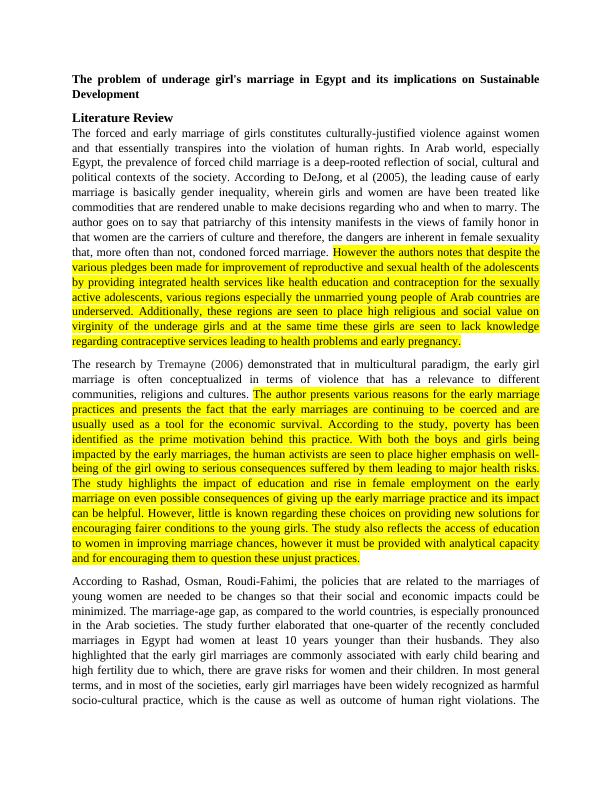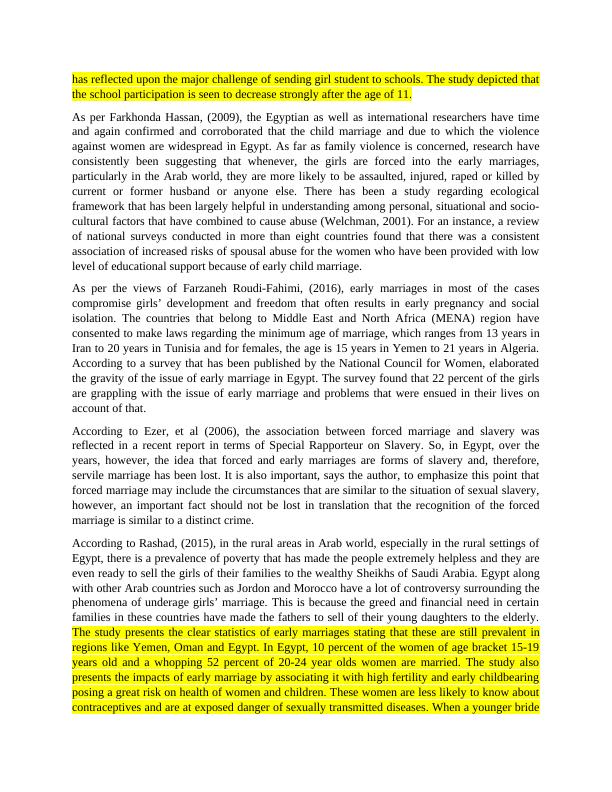Implications on Sustainable Development Literature
7 Pages3574 Words148 Views
Added on 2019-09-25
Implications on Sustainable Development Literature
Added on 2019-09-25
ShareRelated Documents
The problem of underage girl's marriage in Egypt and its implications on SustainableDevelopmentLiterature ReviewThe forced and early marriage of girls constitutes culturally-justified violence against womenand that essentially transpires into the violation of human rights. In Arab world, especiallyEgypt, the prevalence of forced child marriage is a deep-rooted reflection of social, cultural andpolitical contexts of the society. According to DeJong, et al (2005), the leading cause of earlymarriage is basically gender inequality, wherein girls and women are have been treated likecommodities that are rendered unable to make decisions regarding who and when to marry. Theauthor goes on to say that patriarchy of this intensity manifests in the views of family honor inthat women are the carriers of culture and therefore, the dangers are inherent in female sexualitythat, more often than not, condoned forced marriage. However the authors notes that despite thevarious pledges been made for improvement of reproductive and sexual health of the adolescentsby providing integrated health services like health education and contraception for the sexuallyactive adolescents, various regions especially the unmarried young people of Arab countries areunderserved. Additionally, these regions are seen to place high religious and social value onvirginity of the underage girls and at the same time these girls are seen to lack knowledgeregarding contraceptive services leading to health problems and early pregnancy.The research by Tremayne (2006) demonstrated that in multicultural paradigm, the early girlmarriage is often conceptualized in terms of violence that has a relevance to differentcommunities, religions and cultures. The author presents various reasons for the early marriagepractices and presents the fact that the early marriages are continuing to be coerced and areusually used as a tool for the economic survival. According to the study, poverty has beenidentified as the prime motivation behind this practice. With both the boys and girls beingimpacted by the early marriages, the human activists are seen to place higher emphasis on well-being of the girl owing to serious consequences suffered by them leading to major health risks.The study highlights the impact of education and rise in female employment on the earlymarriage on even possible consequences of giving up the early marriage practice and its impactcan be helpful. However, little is known regarding these choices on providing new solutions forencouraging fairer conditions to the young girls. The study also reflects the access of educationto women in improving marriage chances, however it must be provided with analytical capacityand for encouraging them to question these unjust practices.According to Rashad, Osman, Roudi-Fahimi, the policies that are related to the marriages ofyoung women are needed to be changes so that their social and economic impacts could beminimized. The marriage-age gap, as compared to the world countries, is especially pronouncedin the Arab societies. The study further elaborated that one-quarter of the recently concludedmarriages in Egypt had women at least 10 years younger than their husbands. They alsohighlighted that the early girl marriages are commonly associated with early child bearing andhigh fertility due to which, there are grave risks for women and their children. In most generalterms, and in most of the societies, early girl marriages have been widely recognized as harmfulsocio-cultural practice, which is the cause as well as outcome of human right violations. The

prominent difficulties, according to Cammack, et al (1996), with child marriages is that theyundermine the rights of the girls to autonomy, to live a life free from violence and coercion aswell as their rights of obtaining education is severely curtailed. This study by Cammack (1996),redirects the 1974 legislation for the adat and Islamic law in order to restrict child marriage andto curtail polygyny and arbitrary divorce and illustrated that this law has a very low influence onthe age of marriage. This study also depicts that the rural households are encouragingmisreporting of age on the legal documents.Apart from the studies conducted in the societies of the Arab world, there have been a number ofother research works in Sub-Saharan Africa as well, wherein in the name of child marriages,several rights of thee young women are being violated in practice. According to Warner (2005),the political will regarding the changing of prevalent laws about child marriages in thesecountries, are either reluctant or vary considerably from country to country or have been fairlyinconsistent. The study discussed the failure of international covenants and domestic laws withrespect to the child marriage owning to the exceptions when the laws are protecting the religiouspractices or the traditional customary and the victims is being married to the abuser. The studyalso reflected that these conventions lack enforcement mechanisms as they fail to recognize thevulnerabilities of these young children with coerced consent. The reasons according to this studywere found to fetching of higher price, parental desire, and related financial reasons. The articleshas set out various recommendations of extra-legal and legal measures in order to fight againstthe child marriage.According to Dominic Chavez, (2015), a recent report of World Bank, around 17% girls in Egyptare married before they could see their 18th birthday. Chavez finds that while, on the one hand,the incidents of child marriages in Egypt is on the decline, but on the other hand, the religiousand traditional customs and ideals have significantly hindered this process. Girls’disproportionate access to education is among the key causes of child marriage in Egypt. 13% offemales and 3% of males aged 10 to 29 have never been to school. In Egypt, as soon as the girlsreach to the age of puberty, the community norms start dictating their lives and they are made tobe married, with which perpetuating cycle of illiteracy and poverty starts. The study focuseshighly on the human trafficking in the name of early marriage in Egypt where Egyptian girls arebought for temporary marriages and are forced into labour or prostitution. These efforts aresupported by the girls’ families who are benefited from the transaction. The report concludes bypresenting two approaches namely the rights based approach in order to ensure the child’s rightthat are being upheld by the customs and religious acts and not merely by constitution and apartnership approach for integration of civil society, government and private sector.According to an in depth study conducted by Smits, (2007)the child marriage jeopardizes theemotional and physical well-being of the girls because they are prematurely being forced intosexual activity and with that they are systematically exposed to more sexual violence. There is agrowing concern in the world community because they have started to understand that early girlmarriages is an extremely severe human right violation that has greatly curtailed the libertieswith which children are entitled. The author did not hesitate to state that the child marriageinterferes the natural trajectory of growth, learning, social and emotional processes. The study

has reflected upon the major challenge of sending girl student to schools. The study depicted thatthe school participation is seen to decrease strongly after the age of 11.As per Farkhonda Hassan, (2009), the Egyptian as well as international researchers have timeand again confirmed and corroborated that the child marriage and due to which the violenceagainst women are widespread in Egypt. As far as family violence is concerned, research haveconsistently been suggesting that whenever, the girls are forced into the early marriages,particularly in the Arab world, they are more likely to be assaulted, injured, raped or killed bycurrent or former husband or anyone else. There has been a study regarding ecologicalframework that has been largely helpful in understanding among personal, situational and socio-cultural factors that have combined to cause abuse (Welchman, 2001). For an instance, a reviewof national surveys conducted in more than eight countries found that there was a consistentassociation of increased risks of spousal abuse for the women who have been provided with lowlevel of educational support because of early child marriage.As per the views of Farzaneh Roudi-Fahimi, (2016), early marriages in most of the casescompromise girls’ development and freedom that often results in early pregnancy and socialisolation. The countries that belong to Middle East and North Africa (MENA) region haveconsented to make laws regarding the minimum age of marriage, which ranges from 13 years inIran to 20 years in Tunisia and for females, the age is 15 years in Yemen to 21 years in Algeria.According to a survey that has been published by the National Council for Women, elaboratedthe gravity of the issue of early marriage in Egypt. The survey found that 22 percent of the girlsare grappling with the issue of early marriage and problems that were ensued in their lives onaccount of that.According to Ezer, et al (2006), the association between forced marriage and slavery wasreflected in a recent report in terms of Special Rapporteur on Slavery. So, in Egypt, over theyears, however, the idea that forced and early marriages are forms of slavery and, therefore,servile marriage has been lost. It is also important, says the author, to emphasize this point thatforced marriage may include the circumstances that are similar to the situation of sexual slavery,however, an important fact should not be lost in translation that the recognition of the forcedmarriage is similar to a distinct crime.According to Rashad, (2015), in the rural areas in Arab world, especially in the rural settings ofEgypt, there is a prevalence of poverty that has made the people extremely helpless and they areeven ready to sell the girls of their families to the wealthy Sheikhs of Saudi Arabia. Egypt alongwith other Arab countries such as Jordon and Morocco have a lot of controversy surrounding thephenomena of underage girls’ marriage. This is because the greed and financial need in certainfamilies in these countries have made the fathers to sell of their young daughters to the elderly.The study presents the clear statistics of early marriages stating that these are still prevalent inregions like Yemen, Oman and Egypt. In Egypt, 10 percent of the women of age bracket 15-19years old and a whopping 52 percent of 20-24 year olds women are married. The study alsopresents the impacts of early marriage by associating it with high fertility and early childbearingposing a great risk on health of women and children. These women are less likely to know aboutcontraceptives and are at exposed danger of sexually transmitted diseases. When a younger bride

End of preview
Want to access all the pages? Upload your documents or become a member.
Related Documents
Underage Girls’ Marriage in Egypt: Its Implications on Sustainable Developmentlg...
|4
|1060
|177
The Problem of Underage Girl's Marriage in Egyptlg...
|8
|3765
|170
The problem of underage girl's marriage in underprivileged areas of Egyptlg...
|4
|1396
|279
Underage Girls’ Marriage in Egypt: Its Implications on Sustainable Developmentlg...
|6
|2456
|131
Research Proposal: Sustainable Development of Societylg...
|7
|2786
|404
Girls’ Marriage in Egypt: Poverty and Gender Inequalitieslg...
|4
|1398
|285
